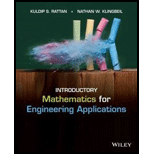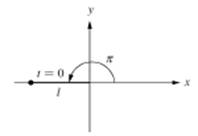
The tip of a one-link robot is located at

FIGURE P6.6 Rotating one-link robot starting at
Want to see the full answer?
Check out a sample textbook solution
Chapter 6 Solutions
Introductory Mathematics for Engineering Applications
Additional Math Textbook Solutions
A Problem Solving Approach To Mathematics For Elementary School Teachers (13th Edition)
Using and Understanding Mathematics: A Quantitative Reasoning Approach (6th Edition)
College Algebra (7th Edition)
Pre-Algebra Student Edition
Elementary Statistics: Picturing the World (7th Edition)
Elementary Statistics (13th Edition)
- (a) State, without proof, Cauchy's theorem, Cauchy's integral formula and Cauchy's integral formula for derivatives. Your answer should include all the conditions required for the results to hold. (8 marks) (b) Let U{z EC: |z| -1}. Let 12 be the triangular contour with vertices at 0, 2-2 and 2+2i, parametrized in the anticlockwise direction. Calculate dz. You must check the conditions of any results you use. (d) Let U C. Calculate Liz-1ym dz, (z - 1) 10 (5 marks) where 2 is the same as the previous part. You must check the conditions of any results you use. (4 marks)arrow_forward(a) Suppose a function f: C→C has an isolated singularity at wЄ C. State what it means for this singularity to be a pole of order k. (2 marks) (b) Let f have a pole of order k at wЄ C. Prove that the residue of f at w is given by 1 res (f, w): = Z dk (k-1)! >wdzk−1 lim - [(z — w)* f(z)] . (5 marks) (c) Using the previous part, find the singularity of the function 9(z) = COS(πZ) e² (z - 1)²' classify it and calculate its residue. (5 marks) (d) Let g(x)=sin(211). Find the residue of g at z = 1. (3 marks) (e) Classify the singularity of cot(z) h(z) = Z at the origin. (5 marks)arrow_forward1. Let z = x+iy with x, y Є R. Let f(z) = u(x, y) + iv(x, y) where u(x, y), v(x, y): R² → R. (a) Suppose that f is complex differentiable. State the Cauchy-Riemann equations satisfied by the functions u(x, y) and v(x,y). (b) State what it means for the function (2 mark) u(x, y): R² → R to be a harmonic function. (3 marks) (c) Show that the function u(x, y) = 3x²y - y³ +2 is harmonic. (d) Find a harmonic conjugate of u(x, y). (6 marks) (9 marks)arrow_forward
- Let A be a vector space with basis 1, a, b. Which (if any) of the following rules turn A into an algebra? (You may assume that 1 is a unit.) (i) a² = a, b² = ab = ba = 0. (ii) a²=b, b² = ab = ba = 0. (iii) a²=b, b² = b, ab = ba = 0.arrow_forwardNo chatgpt pls will upvotearrow_forward= 1. Show (a) Let G = Z/nZ be a cyclic group, so G = {1, 9, 92,...,g" } with g": that the group algebra KG has a presentation KG = K(X)/(X” — 1). (b) Let A = K[X] be the algebra of polynomials in X. Let V be the A-module with vector space K2 and where the action of X is given by the matrix Compute End(V) in the cases (i) x = p, (ii) xμl. (67) · (c) If M and N are submodules of a module L, prove that there is an isomorphism M/MON (M+N)/N. (The Second Isomorphism Theorem for modules.) You may assume that MON is a submodule of M, M + N is a submodule of L and the First Isomorphism Theorem for modules.arrow_forward
- (a) Define the notion of an ideal I in an algebra A. Define the product on the quotient algebra A/I, and show that it is well-defined. (b) If I is an ideal in A and S is a subalgebra of A, show that S + I is a subalgebra of A and that SnI is an ideal in S. (c) Let A be the subset of M3 (K) given by matrices of the form a b 0 a 0 00 d Show that A is a subalgebra of M3(K). Ꮖ Compute the ideal I of A generated by the element and show that A/I K as algebras, where 0 1 0 x = 0 0 0 001arrow_forward(a) Let HI be the algebra of quaternions. Write out the multiplication table for 1, i, j, k. Define the notion of a pure quaternion, and the absolute value of a quaternion. Show that if p is a pure quaternion, then p² = -|p|². (b) Define the notion of an (associative) algebra. (c) Let A be a vector space with basis 1, a, b. Which (if any) of the following rules turn A into an algebra? (You may assume that 1 is a unit.) (i) a² = a, b²=ab = ba 0. (ii) a² (iii) a² = b, b² = abba = 0. = b, b² = b, ab = ba = 0. (d) Let u1, 2 and 3 be in the Temperley-Lieb algebra TL4(8). ገ 12 13 Compute (u3+ Augu2)² where A EK and hence find a non-zero x € TL4 (8) such that ² = 0.arrow_forwardQ1: Solve the system x + x = t², x(0) = (9)arrow_forward
- Between the function 3 (4)=x-x-1 Solve inside the interval [1,2]. then find the approximate Solution the root within using the bisection of the error = 10² method.arrow_forwardE10) Perform four iterations of the Jacobi method for solving the following system of equations. 2 -1 -0 -0 XI 2 0 0 -1 2 X3 0 0 2 X4 With x(0) (0.5, 0.5, 0.5, 0.5). Here x = (1, 1, 1, 1)". How good x (5) as an approximation to x?arrow_forwardby (2) Gauss saidel - - method find (2) و X2 for the sestem X1 + 2x2=-4 2x1 + 2x2 = 1 Such thef (0) x2=-2arrow_forward
- Algebra & Trigonometry with Analytic GeometryAlgebraISBN:9781133382119Author:SwokowskiPublisher:Cengage
 Trigonometry (MindTap Course List)TrigonometryISBN:9781305652224Author:Charles P. McKeague, Mark D. TurnerPublisher:Cengage Learning
Trigonometry (MindTap Course List)TrigonometryISBN:9781305652224Author:Charles P. McKeague, Mark D. TurnerPublisher:Cengage Learning

